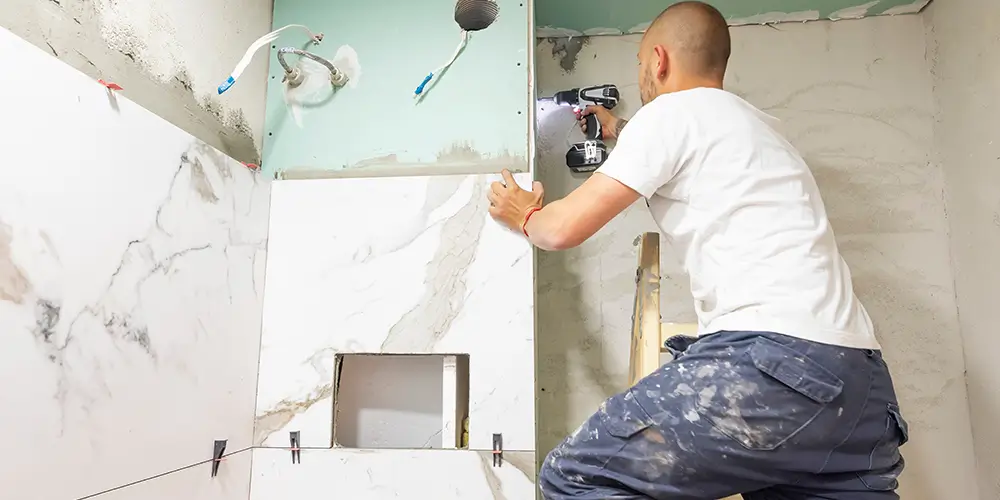A bathroom renovation is the most popular home makeover project. It’s easy to see why.
- The bathroom is one of the most used rooms of a house. A renovation can update fixtures, tiles, lighting, and even heating, making the space more pleasant and easier to clean.
- A bathroom renovation can increase the value of a home.
- A bathroom renovation can improve energy and water efficiency. Upgrades to low-flow fixtures, LED lighting, and energy-efficient windows will save money on utility bills and reduce your carbon footprint.
Older Bathrooms May Need Extra Work
Some bathrooms have decades-old plumbing and electrical wiring unsuitable for modern fixtures and appliances.
But bathrooms often come with other problems as well. Here are ten common issues you may encounter during the renovation, and here’s what you can do about them.
1. Mold in the Ceiling & Walls
Mold ranks as the top problem in American bathrooms. Black mold loves warm, moist environments that feed its growth. Telltale signs of mold include:
- Black spots near the ceiling
- Black spots just above your bathroom baseboards
- Drywall that stays wet long after you’ve bathed
Another possible but less reliable indicator is a musty smell in the air.
Mold growth can be dangerous, leading to respiratory issues, skin and eye irritation, allergic reactions, and long-term health problems. In severe cases, you may need to replace the entire bathroom — that is, floor, ceiling, and walls — and bring in specialists to remove all traces.
- Start by identifying the sources of mold growth: faulty plumbing or leaks, condensation from poor ventilation or lack of insulation, shower curtains, or damp towels left around for too long. Eliminate the moisture sources as much as possible and dry off all surfaces after showers and baths.
- Check the edges of your bathroom walls and flooring for any signs of wetness or discoloration. If needed, reseal around door frames, windowsills, and other mounts with caulking or silicone sealant to prevent further water infiltration into your walls.
2. Poor Ventilation & Vent Fans
Vent fans remove humidity, retarding mold growth. If you don’t have a vent fan in your bathroom, consider installing one — the cost is minimal compared to dealing with mold problems later.
If you already have a vent fan, but bathroom humidity remains a problem, the fan may be underpowered. The typical volume for a bathroom vent fan is 50-100 cubic feet per minute (CFM).
All vents must be vented outside, not just to an attic or crawl space. A poorly insulated bathroom with a badly designed exhaust system invites mold growth.
3. Outdated Fixtures & Pipes
Older bathrooms may contain lead-based or galvanized steel piping, which corrodes over time and contaminates water supplies. Discoloration or rust stains on the pipes and fittings and a sour, metallic taste in your taps are indications of trouble.
Toilets last up to 20 years with regular use; anything older is a candidate for replacement. New toilets are much more efficient and comfortable than older models; you may wonder why you waited so long to upgrade.
Consider replacing all fixtures with modern ones. Switch to PVC, PEX, or copper piping for better flow rates and fewer leaks. At Orange Coast Plumbing, we use copper exclusively for bathroom plumbing because it’s long-lasting and impervious to pest damage.
4. Clogged, Slow, or Malfunctioning Drains
Hair and soap scum are responsible for most shower and sink drain clogs. Pouring hot water down the drain can help, but it’s a temporary fix. At some point, you may have to remove the clog manually or use chemical cleaners, augers, or snakes.
Chemical cleaners don’t always work, and snakes have a limited reach. Drain clogs can also result from pipe corrosion or installation errors. If you’ve noticed puddles of water near your shower and sink drains, and if your toilet also backs up, the clog may lie in the main sewer line.
A plumber’s hydro jet can clear almost any sewer clog, including tree root invasion. But a collapsed (broken) sewer pipe is beyond repair. It must be excavated and replaced or burst and replaced with a trenchless repair.
5. Lack of Space
Short of carving out more floor area for your remodeled bathroom, you can do several things to maximize existing space.
- Install a pedestal sink, wall-mounted toilet, and other fixtures that take up little or no floor space.
- Use recessed or floating cabinets and shelves to store cosmetics and toiletries.
- Remove that old tub you don’t need; many bathrooms are now tub-free.
- Consider replacing your vanity with a smaller sink and countertop.
- Use vertical space by adding wall-mounted shelves, towel racks, etc.
- Opt for a light color scheme to make the room look airy and spacious.
6. Poor Lighting
Lighting is almost an afterthought in many bathroom designs. It shouldn’t be.
Invest in bright LED bulbs or add fixtures like recessed lighting near mirrors. Incorporate dimmers and different colors of lightbulbs into your design plan, allowing you to create different moods for your favorite bathroom activities.
7. Noisy Pipes
Hydraulic shock (water hammer can happen when you suddenly shut off a faucet. Water continues moving through the pipe, bouncing off closed valves and causing vibrations that create noise.
A simple solution is to add an air chamber near each fixture in the piping system. Air chambers provide a space to absorb shock waves and eliminate sound. You can also install special flow-control valves, like pressure-reducing valves or backflow preventers, which reduce water hammer.
8. Inadequate Hot Water
The bathroom, which uses the most water in a home, is often furthest from the water heater in the garage. Hot water must travel through 50 feet of pipe or more before it reaches the shower head.
A tankless water heater installed near the bathroom can solve this problem. Tankless heaters provide on-demand hot water and use less energy than conventional heaters.
9. Inadequate Electrical Wiring
Even in a recently-build home, a tankless heater places extraordinary demands on existing electrical wiring. Inadequate capacity will overload the system and trip the breaker.
Before attempting a bathroom renovation, always check your home’s electrical capacity and consider upgrading. You may need to install new circuit breakers or run additional circuits for water heaters, steam showers, bathroom heating systems, etc.
10. Cold Floors
Sure, you can bury the cold bathroom floor under layers of bathmats, but have you ever considered radiant underfloor heating?
Hydronic heating circulates hot water through pipes installed in the floor or walls, radiating heat into the room. This type of heating works particularly well in bathrooms for several reasons.
- Bathrooms are smaller spaces with high moisture levels, making them feel colder. Hydronic coils provide a consistent and comfortable heat source, alleviating the chill and preventing mold and mildew growth.
- Bathroom floors often have hard, cold surfaces like tile or stone that feel harsh to bare feet. Hydronic radiant heating warms these surfaces, reducing the shock of stepping out of a warm shower onto a cold floor.
- Hydronic radiant heating is quiet and efficient. Unlike forced air systems, which can be noisy and disruptive, hydronic radiant heating operates silently and provides a consistent source of heat that doesn’t create drafts or hot spots.
Your Bathroom Renovators in Orange County
Orange Coast Plumbing works with some of Orange County’s best interior designers who have remodeled dozens of homes, offices, and commercial spaces.
For plumbing remodeling jobs, we may:
- Completely repipe portions of a home or business
- Replace fixtures and toilets with modern models that use less water
- Move fixtures or pipes around a kitchen to create more counter space
- Replace traditional water heaters with tankless models
- Make small adjustments to venting systems, valves, drainage, and other parts of the existing system
- And much more
Experience matters. We’ll design the most efficient and aesthetically pleasing bathroom for your home and work with other contractors to get your bathroom back to normal as soon as possible.
Call us today for a free estimate.
FAQs: Bathroom Plumbing Renovation
Q: What’s the average cost of a bathroom renovation, including plumbing?
A bathroom renovation can cost from $5,000 to $25,000 or more, depending on the extent of work needed, materials chosen, and complexity of the plumbing adjustments.
Q: How long does a bathroom renovation take?
It can take anywhere from a few weeks to several months. Factors that influence the timeline include the scope of the project, availability of materials, and coordination with contractors.
Q: Do I need a permit for plumbing renovations?
Yes, most plumbing renovations require permits to ensure that the work meets local building codes. Check with your local authorities or your contractor to determine the necessary permits for your project.
Q: Can I do plumbing repairs or upgrades myself?
While DIYers can manage minor repairs, most plumbing upgrades, particularly those involving significant changes to the system, should be handled by licensed professionals to avoid potential issues and ensure compliance with codes.
Q: What plumbing fixtures should I consider replacing during a renovation?
It’s an excellent opportunity to replace outdated fixtures such as faucets, toilets, and sinks with water-efficient models. You might also consider upgrading your shower head, bathtub, or even the piping itself.
Q: How can I save on plumbing costs during a renovation?
You can keep the existing plumbing layout, choose cost-effective fixtures, and consider completing certain tasks yourself, such as painting or installing non-plumbing elements.
Q: Should I upgrade to a tankless water heater?
A tankless water heater provides an endless supply of hot water on-demand and takes up less space, making it a great option during renovations.
Q: How can I ensure my bathroom is energy-efficient?
Consider installing water-saving fixtures, LED lighting, and radiant floor heating systems. Proper insulation and sealing will also improve energy efficiency.
Q: What should I expect during the renovation process?
Expect some disruption to your daily routine, especially if your bathroom is out of service. A professional contractor will provide a clear timeline and updates throughout the project to keep you informed.


